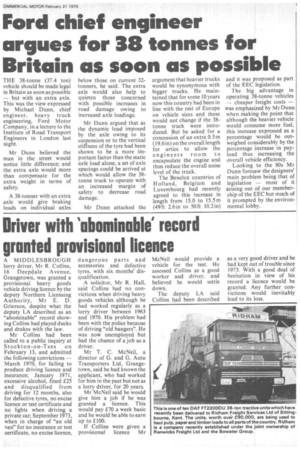Ford chief engineer argues for 38 tonnes for Britain as soon as possible
Page 19

If you've noticed an error in this article please click here to report it so we can fix it.
THE 38-tonne (37.4 ton) vehicle should be made legal in Britain as soon as possible — but with an extra axle. This was the view expressed by Michael Dunn, chief engineer, heavy truck engineering, Ford Motor Company, in a lecture to the Institute of Road Transport Engineers in London last night.
Mr Dunn believed the man in the street would notice little difference; and the extra axle would more than compensate for the extra weight in terms of safety.
A 38-tonner with an extra axle would give braking loads on individual axles below those on current 32tonners, he said. The extra axle would also help to quieten those concerned with possible increases in road damage owing to increased axle loadings.
Mr Dunn argued that as the dynamic load imposed by the axle owing to its suspension or to the vertical stiffness of the tyre had been shown to be a more important factor than the static axle load alone, a set of axle spacings could be arrived at which would allow the 38tonne truck to operate with an increased margin of safety to decrease road damage.
Mr Dunn attacked the argument that heavier trucks would be synonymous with bigger trucks. He maintained that for some 10 years now this country had been in line with the rest of Europe on vehicle sizes and these would not change if the 38tonne truck were introduced. But he asked for a concession of an extra 0.5m (19.6 in) on the overall length for artics to allow the engineers room to encapsulate the engine and thus reduce the overall noise level of the truck.
The Benelux countries of Holland, Belgium and Luxembourg had recently agreed to this increase in length from 15.0 to 15.5 m (49 ft 2.6in to 50ft 10.2 in) and it was proposed as part of the EEC legislation.
The big advantage in operating 38-tonne vehicles — cheaper freight costs — was emphasized by Mr Dunn when making the point that although the heavier vehicle would consume more fuel, this increase expressed as a percentage would be outweighed considerably by the percentage increase in payload thus increasing the overall vehicle efficiency.
Looking to the 80s Mr Dunn foresaw the designers' main problem being that of legislation — most of it arising out of our membership of the EEC but much of it prompted by the environmental lobby.












































































































